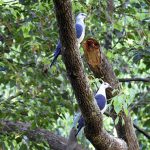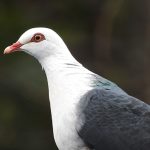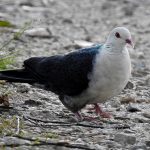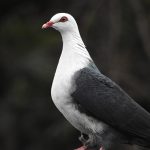WHITE-HEADED PIGEON
White-headed Pigeon
Among rainforest pigeons, the White-headed Pigeon is one of the most adaptable and resilient, and perhaps the most likely to thrive in coastal areas. Its range stretches from Cooktown in far north Queensland down to the Illawarra district in New South Wales. While it largely inhabits the lush eastern coastal strip, it occasionally ventures inland, especially where remnant rainforest or fruiting trees remain.
Behaviour and Temperament
These pigeons are naturally cautious and secretive. When danger approaches, they often freeze among dense foliage or remain motionless on the forest floor, blending into the dappled light and shadow. If flushed into flight, they burst away with an audible whirring clap of wings—a startling sound that warns others of potential threats.
They are typically found in pairs or loose flocks of 15 or more, moving together in search of food. Their diet is varied and seasonal, including seeds, grasses, grains, and fruits. As rainforest trees and shrubs come into fruit, the pigeons follow, acting as mobile seed dispersers and playing an important role in forest regeneration.
When crossing open country, their flight is fast and direct, hugging low altitudes before veering sharply away from anything unfamiliar.
Appearance
The White-headed Pigeon is a striking bird, with its pure white head and neck contrasting sharply against the darker body. Its lower breast and belly are soft grey, while its back, wings, and tail shimmer with a blackish-purple sheen in the sunlight. The eyes are golden-yellow with a red-orange orbital ring, giving an intense, watchful expression. The beak is red with a cream tip, and the feet are pink-red with darker claws.
When seen in the forest canopy, the white head can catch the light like a lantern, making the bird instantly recognisable to those who know what to look for.
Voice and Courtship
Their call is a series of low, resonant coos, which become more frequent and insistent during the breeding season. In early spring, males perform undulating display flights above the treetops before swooping down to perch near a female, where they engage in a slow, deliberate bowing display—a ritual of courtship that has changed little over millennia.
Breeding and Family Life
- Breeding Season: July to March
- Nest Placement: Small, loosely built platform of twigs positioned 3–20 metres above the ground in bushes or trees
- Clutch Size: One to two small cream-coloured eggs
- Incubation: ~20 days, shared by both parents
One of the most fascinating aspects of pigeon biology is that both parents produce a substance called pigeon’s milk—a nutrient-rich, creamy secretion from the crop that is fed to the chicks. This unique adaptation allows the young to grow rapidly.
Newly hatched chicks are covered in rust-coloured down, a stark contrast to the immaculate plumage of their parents. Adults possess powder down—fine, dusty feathers that can be released, particularly from the tail, in a defensive display against predators.
Chicks fledge in about 21–22 days but often remain close to their parents, joining the larger flock as they learn the skills needed to survive. In good seasons, pairs may raise two or three broods, and if eggs or chicks are lost, they will often re-nest quickly.
Ecological Role
These birds are forest gardeners. By consuming a wide range of fruits, they carry seeds far from the parent trees, depositing them in new locations where they can germinate. This seed dispersal is vital to the health of rainforests and coastal woodlands, helping maintain the diversity and resilience of these ecosystems.
Interesting Facts
- Urban Adaptation: While primarily a rainforest pigeon, the species has adapted to living in towns and gardens where fruiting trees are available, particularly camphor laurels and ornamental figs.
- Camphor Laurel Paradox: Although camphor laurel is an invasive weed in Australia, its abundant fruit has provided a year-round food source for White-headed Pigeons, aiding their population stability in modified landscapes.
- Silent Sentries: Their stillness when threatened is a form of camouflage—predators often pass within metres without noticing them.
- Ancient Lineage: The White-headed Pigeon belongs to the same family as the extinct Passenger Pigeon of North America, but unlike its ill-fated cousin, it has adapted well to habitat changes.
- Cultural Recognition: In some Aboriginal traditions, pigeons are considered messengers, and their calls are said to carry news through the forest.
Conservation Note
While the White-headed Pigeon is currently secure and common in many parts of its range, its reliance on fruiting trees means it remains tied to the health of coastal and rainforest habitats. Protecting remnant forests, planting native fruiting trees, and managing invasive species thoughtfully are all part of ensuring these beautiful birds remain a familiar and vital presence in Australia’s wild and urban landscapes.




